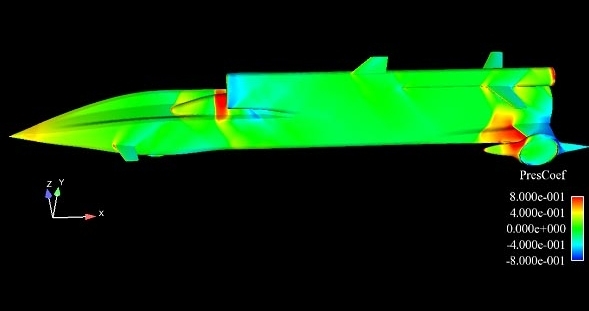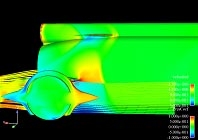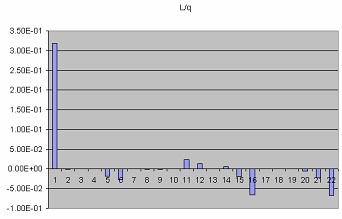
The question of how we keep Andy Green safely pinned to the deck whilst travelling at almost 1.5 times the speed of sound is one that has been hanging over me for what seems like an eternity.
By Dr Ben Evans
A conversation involving brain-taxing explanations and much animated hand-waving convinced me that achieving this was at least theoretically possible. This convincing came from the aerodynamics legend Ron Ayers during my initiation into the BLOODHOUND adventure almost two years ago. Nonetheless, I am someone deeply embedded in the world of CFD (computational fluid dynamics) and so am never 100% confident until ‘the computer says so’.
Two years on, we now find ourselves in the fine-tuning phase of design and we have reached a stage where ‘the computer almost says so’.
The problem is that as a supersonic vehicle accelerates through the sound barrier it generates ‘aerodynamic dragons’ (better known as shock waves).These significantly effect the pressure distribution over BLOODHOUND and cause it to behave quite differently than if it was merely a subsonic vehicle.
We are endeavouring to design a vehicle that generates its own downforce at all times. The ‘pretty pictures’ that we generate describe the pressure distribution over the car, so in them we want to see more reds (high pressure) on upward facing surfaces and blues (low pressure/suction) on downward facing surfaces. The real challenge of late has been achieving this at the back end of the car where the widely spaced rear wheels generate extremely strong shock waves.
 One of the great benefits of CFD analysis over traditional aerodynamic analysis techniques is the ability to decompose the overall forces acting on a complex vehicle in such a way that allows us to understand ‘what bit of the airflow is causing what force’. This kind of breakdown is shown in the plot below showing the lift force on various car components of the current configuration of BLOODHOUND (config5 03/03/09) whilst it travels at MACH 1.3
One of the great benefits of CFD analysis over traditional aerodynamic analysis techniques is the ability to decompose the overall forces acting on a complex vehicle in such a way that allows us to understand ‘what bit of the airflow is causing what force’. This kind of breakdown is shown in the plot below showing the lift force on various car components of the current configuration of BLOODHOUND (config5 03/03/09) whilst it travels at MACH 1.3
 Tallying up all these vertical loads results in an overall L/q (lift divided by dynamic pressure) of +0.648. We can also calculate how much of this net force is distributed between the front wheels and rear wheels (the points at which vertical forces have to be reacted). It is also possible to compute that +0.234 occurs at the front wheels and +0.414 occurs at the rear wheels (perhaps unsurprisingly if you look at how much ‘nasty red’ there is under the back of the vehicle). The important thing here is not so much what the absolute size of this net vertical force is, but the fact that it is positive. This means that we have a net vertical force in the ‘up’ direction, or in other words, we have designed an aeroplane and not a car! However, notice that there is a large amount of positive force being generated in bars 3 & 4 and bars 13 & 19. These are the front winglets and the rear top suspension struts.
Tallying up all these vertical loads results in an overall L/q (lift divided by dynamic pressure) of +0.648. We can also calculate how much of this net force is distributed between the front wheels and rear wheels (the points at which vertical forces have to be reacted). It is also possible to compute that +0.234 occurs at the front wheels and +0.414 occurs at the rear wheels (perhaps unsurprisingly if you look at how much ‘nasty red’ there is under the back of the vehicle). The important thing here is not so much what the absolute size of this net vertical force is, but the fact that it is positive. This means that we have a net vertical force in the ‘up’ direction, or in other words, we have designed an aeroplane and not a car! However, notice that there is a large amount of positive force being generated in bars 3 & 4 and bars 13 & 19. These are the front winglets and the rear top suspension struts.
 This now begs the question, ‘what would happen if we could remove these positive vertical loads on the front winglets and rear suspension struts?’. In principle we could achieve this quite simply by angling these surfaces down until they are no longer generating lift. If we flatten these bars to zero, our force breakdown plot now looks as follows.
This now begs the question, ‘what would happen if we could remove these positive vertical loads on the front winglets and rear suspension struts?’. In principle we could achieve this quite simply by angling these surfaces down until they are no longer generating lift. If we flatten these bars to zero, our force breakdown plot now looks as follows.
 We discover that tallying our vertical loads gives us a net vertical load on the vehicle of +0.137 distributed as +0.136 to the front wheels and +0.001 to the rear wheels. We haven’t completely cured the ‘is it a car or is it an aeroplane?’ problem, but we have taken a considerable step in the right direction.
We discover that tallying our vertical loads gives us a net vertical load on the vehicle of +0.137 distributed as +0.136 to the front wheels and +0.001 to the rear wheels. We haven’t completely cured the ‘is it a car or is it an aeroplane?’ problem, but we have taken a considerable step in the right direction.
Of course, we still have to try these ideas out on a new BLOODHOUND config, combine them with some additional downforce generation ideas and repeat the whole CFD simulation process.
Returning to our initial question, ‘can we safely keep Andy Green pinned to the deck whilst travelling at 1000mph in BLOODHOUND SSC?’ Computer says ‘almost’, so watch this space!
Dr Ben Evans
Swansea University
(BLOODHOUND CFD)

